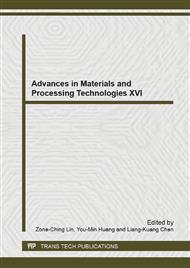p.146
p.152
p.161
p.169
p.177
p.186
p.194
p.201
p.209
Applications of Optical Path Length Compensation Technology for High Power CO2 Laser Cutting Process
Abstract:
High powerCO2(Carbon Dioxide,CO2) laser cutting process not only attention to the type of material selected, the focus position of the laser beam and spot size (beam size) also plays an important role. In this paper, metal materials cutting through the wavelength of 10.6μm,CO2 laser with the optical path length compensation techniquewith output power 4000W. We compare different focus position and spot size for processing quality to discussing the use of a constant optical path length system to maintain the stability of the cross-section of the metal material after laser cutting.Optical path length compensation is used with ABCD Law in metal (steel) laser cutting processing an indispensable technology.Finally, we verify that the cross-section of the optical path length compensation under laser cutting in different processing location, thicknessof 16 mmsteel with laser power 4000W, and cutting speed 0.9 m/minconditions observed area 3*1.5 m2workingstagefor optical path length of 7, 8.5, 10 and 11.5 m,the steel ofcross-section appearance almost identical.
Info:
Periodical:
Pages:
177-185
Citation:
Online since:
May 2014
Authors:
Keywords:
Price:
Сopyright:
© 2014 Trans Tech Publications Ltd. All Rights Reserved
Share:
Citation:


